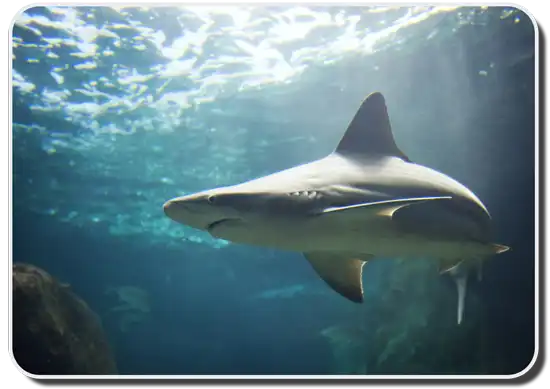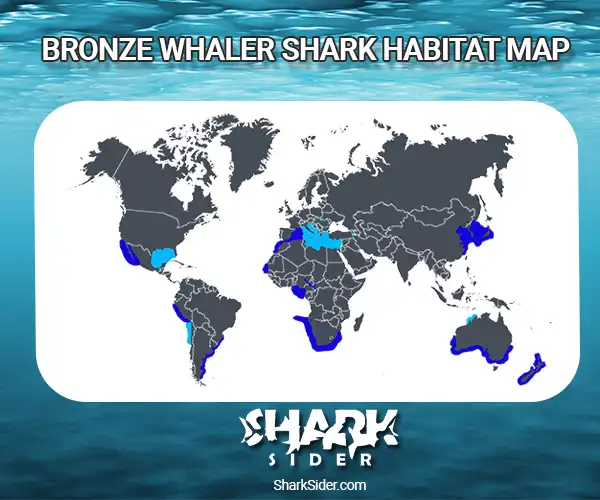The Bronze Whaler Shark is known as Carcharhinus brachyurus in the scientific community. It is also known as the Narrowtooth, Bronze Whaler or the Copper Shark. This breed also belongs to the requiem species of shark. They can grow up to a length of 11 feet (about 3.3 meters). While they do not have any special distinguishing marks, they do have a highly recognizable ridge right between the dorsal fins which is bronze in color. The teeth are also a little different than other requiem sharks being hook shaped and narrow.

These sharks are not friendly to humans, but they usually don’t harm anyone unless there is a presence of food or prey. Like other sharks, they get quite aggressive and agitated in presence of a food source. The Bronze Whaler Shark feeds mostly on cartilaginous fish, bony small fish and other cephalopods and in nature a not-so-aggressive predator. It is also known to feed on smaller sharks and ray fish quite frequently.
Habitat
The Bronze Whaler Shark is normally found in temperate areas or latitudes and they prefer to stay in larger groups. Although it prefers the deeper waters of the Atlantic, especially off the coast of South Africa, New Zealand and Australia, they are also found in offshore island coastlines, inlet waterways, and man-made harbors. Other areas they have been spotted include The Mediterranean, coast of Argentina, Gulf of Mexico and Indo-Pacific regions. These sharks are known to migrate with the seasons and males and females of the species do not co-exist throughout the entire year. This is one reason why they are sighted almost everywhere south of the equator.
They are known to exist in waters above 12 degrees centigrade and prefer waters that are 100 meters (330 feet) deep. They usually aren’t found in shallow waters. When they exist in inlets, they are in water that is at least 100 meters deep. The shark is very sensitive to the salinity of water around it and migrates accordingly. The younger ones or juveniles are normally found in shallow waters that are less than 30 meters deep (about 100 feet) around the year until they grow to be adults. They sharks prefer depths and look coast-wards in summer and spring.
Migrations of the Copper Shark are attributed to many reasons – reproductive events, availability of food, temperature changes etc. The migration patterns also vary with age and sex. During such times, the Bronze Whaler Sharks are known to travel in excess of 1300 kilometers.
Bronze Whaler Shark Habitat Map

Social Behavior
The Bronze Whaler Shark does not hunt individually and normally does so in large groups. The numbers are used to their advantage when encountering large prey. Conversely, on the South African coast, each shark can consume millions of sardines.
The Bronze Whaler Shark or the Copper Shark is certified as near threatened (by IUN) and its numbers are progressively growing lower due to commercial fishing. This shark is fished for its meat which is normally eaten salted. Another reason for its decline is the lower reproduction rates. A catch and release program is effect for the copper sharks in New Zealand as well as Namibia. Fishing for this shark is banned and commercial, hobby or recreational fisheries that catch them tend to send them back to sea.
Despite its size and aggressive predatory behavior, they haven’t proven to be a real threat to humans. The only known fatal attack by a Bronze Whaler Shark is dated in September of 2011 and happened in Australia’s Bunker Bay. The International Shark Attack File documents and lists about thirty three attacks on humans and boats and none of them were fatal. The attacks on humans by the Copper Shark have been mostly on spear-fishers and a few Australian bathers. As any large predator, this shark also becomes hostile in presence of food and the attacks on spear-fishers are attributed to stealing their catch.
Offspring
As all other requiem sharks, the Bronze Whaler is Viviparous which means they are similar to humans in that female fish carries her young as they develop inside of her. The mating process involves biting which can lead to minor injuries, but these bites are not fatal. The normal mating period is during October – December and the gestation period for pregnancy is estimated to be around a year to a year and a half. The pups are born during the June to January period every other year.
Litters are sized from seven to twenty four and measure about 24 inches in length when born. The nurseries where the babies are born are selected by the female Shark and are usually in the more protected areas of the sea or coastal areas like the inlet waterways and harbors.
The pups grow quite slowly and reach a size of around 7 feet when they are between 13 to 19 years of age; this is when they become adults. Females grow to be about 8 feet long before becoming adults and are aged about 20. The lifespan of the female Bronze Whaler Shark is about 25 years and 30 years for males.
Remarkably, although these sharks roam the waters in large numbers, the behavior of these sharks is not entirely known to humans. For example, the migratory habits are still a puzzle. There is no saying where a Bronze Whaler Shark will migrate to once the conditions are not conducive, but it will return to the same waters year after year.
Page Created By: Mike Rogers
From Bronze Whaler Shark to Types Of Sharks
